Introduction to Financial Accounting Assignment Solution
VerifiedAdded on 2023/01/07
|15
|3525
|73
Homework Assignment
AI Summary
This document presents a comprehensive solution to an Introduction to Financial Accounting assignment. The solution includes the preparation of a trading account, profit and loss account, and a statement of financial position based on a provided trial balance. It also evaluates the key features of financial information for users, explaining their importance and benefits. Additionally, the assignment covers ratio analysis, including gross profit margin, return on capital employed, current ratio, and trade payables/receivables periods, with interpretations. Furthermore, it addresses the creation of bank accounts, purchase accounts, and other relevant accounts, along with a trial balance. Finally, it delves into depreciation methods (straight-line and reducing balance), and explains significant accounting concepts.
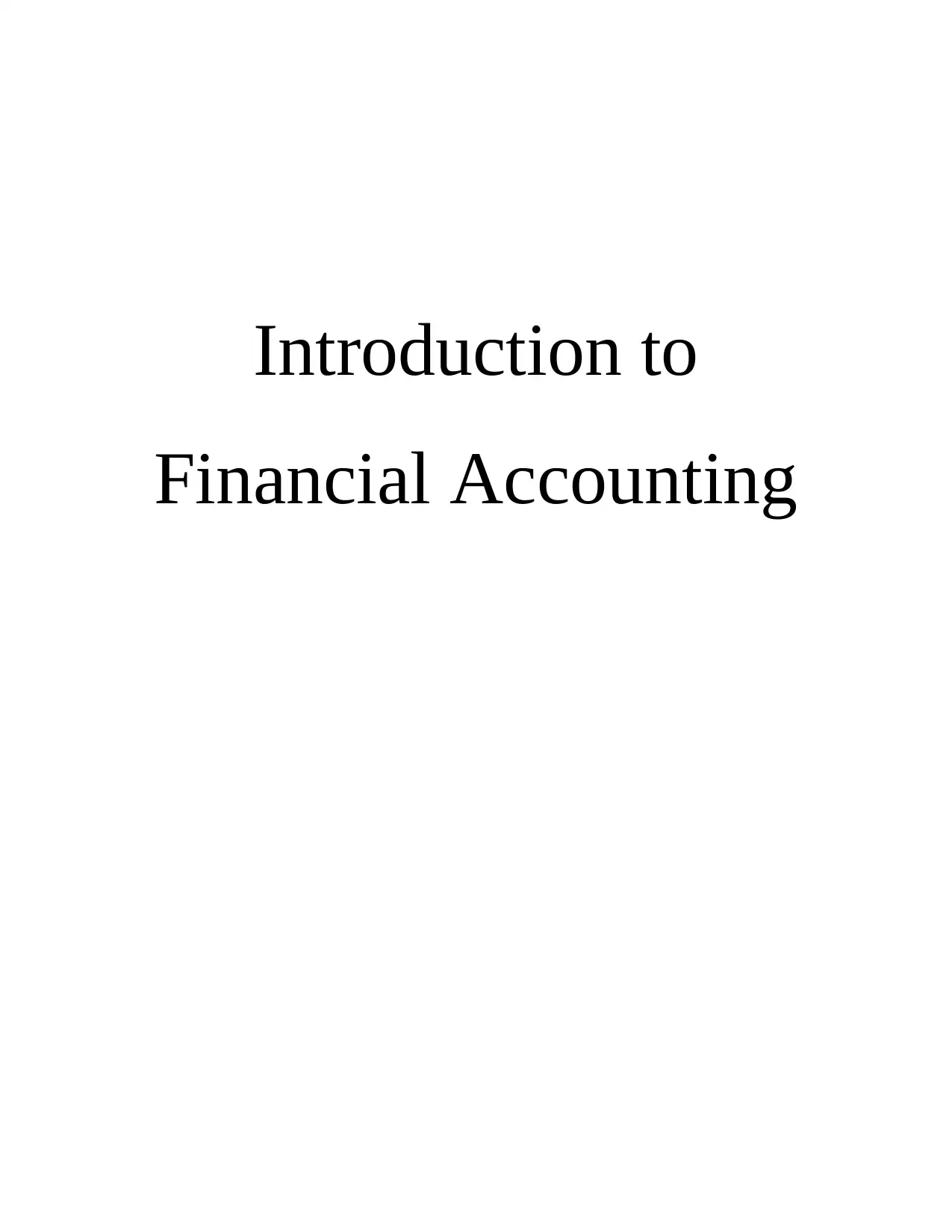
Introduction to
Financial Accounting
Financial Accounting
Paraphrase This Document
Need a fresh take? Get an instant paraphrase of this document with our AI Paraphraser
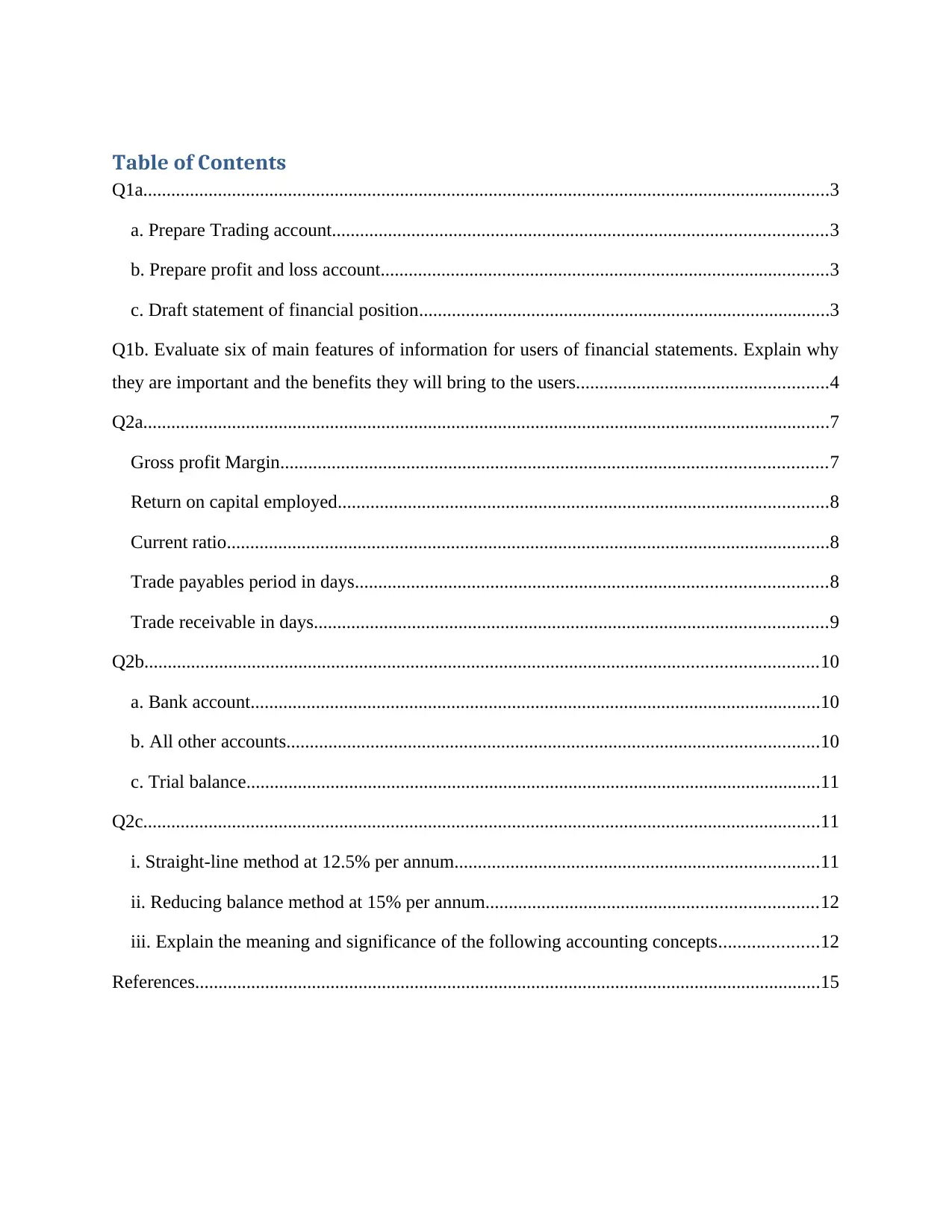
Table of Contents
Q1a...................................................................................................................................................3
a. Prepare Trading account..........................................................................................................3
b. Prepare profit and loss account................................................................................................3
c. Draft statement of financial position........................................................................................3
Q1b. Evaluate six of main features of information for users of financial statements. Explain why
they are important and the benefits they will bring to the users......................................................4
Q2a...................................................................................................................................................7
Gross profit Margin.....................................................................................................................7
Return on capital employed.........................................................................................................8
Current ratio.................................................................................................................................8
Trade payables period in days.....................................................................................................8
Trade receivable in days..............................................................................................................9
Q2b................................................................................................................................................10
a. Bank account..........................................................................................................................10
b. All other accounts..................................................................................................................10
c. Trial balance...........................................................................................................................11
Q2c.................................................................................................................................................11
i. Straight-line method at 12.5% per annum..............................................................................11
ii. Reducing balance method at 15% per annum.......................................................................12
iii. Explain the meaning and significance of the following accounting concepts.....................12
References......................................................................................................................................15
Q1a...................................................................................................................................................3
a. Prepare Trading account..........................................................................................................3
b. Prepare profit and loss account................................................................................................3
c. Draft statement of financial position........................................................................................3
Q1b. Evaluate six of main features of information for users of financial statements. Explain why
they are important and the benefits they will bring to the users......................................................4
Q2a...................................................................................................................................................7
Gross profit Margin.....................................................................................................................7
Return on capital employed.........................................................................................................8
Current ratio.................................................................................................................................8
Trade payables period in days.....................................................................................................8
Trade receivable in days..............................................................................................................9
Q2b................................................................................................................................................10
a. Bank account..........................................................................................................................10
b. All other accounts..................................................................................................................10
c. Trial balance...........................................................................................................................11
Q2c.................................................................................................................................................11
i. Straight-line method at 12.5% per annum..............................................................................11
ii. Reducing balance method at 15% per annum.......................................................................12
iii. Explain the meaning and significance of the following accounting concepts.....................12
References......................................................................................................................................15
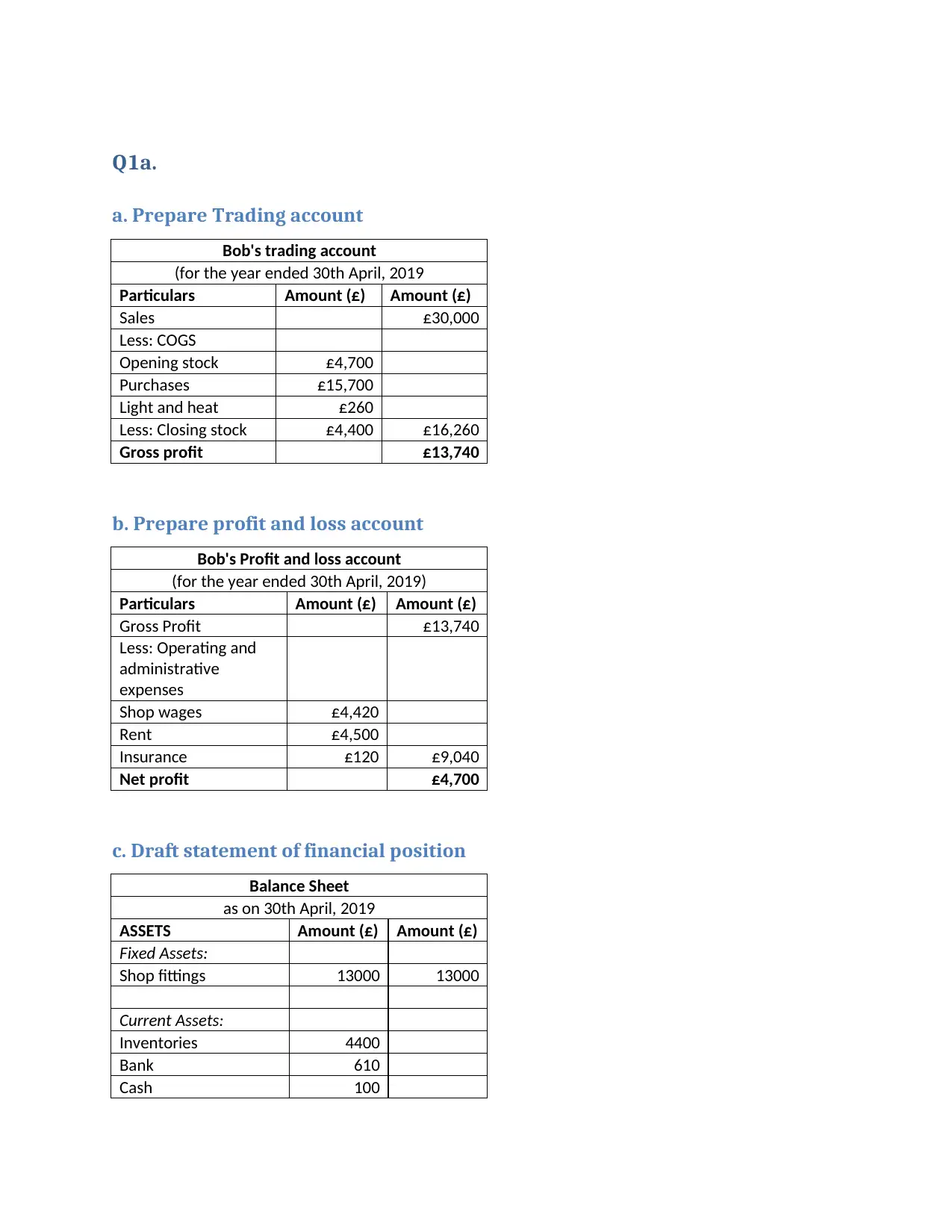
Q1a.
a. Prepare Trading account
Bob's trading account
(for the year ended 30th April, 2019
Particulars Amount (£) Amount (£)
Sales £30,000
Less: COGS
Opening stock £4,700
Purchases £15,700
Light and heat £260
Less: Closing stock £4,400 £16,260
Gross profit £13,740
b. Prepare profit and loss account
Bob's Profit and loss account
(for the year ended 30th April, 2019)
Particulars Amount (£) Amount (£)
Gross Profit £13,740
Less: Operating and
administrative
expenses
Shop wages £4,420
Rent £4,500
Insurance £120 £9,040
Net profit £4,700
c. Draft statement of financial position
Balance Sheet
as on 30th April, 2019
ASSETS Amount (£) Amount (£)
Fixed Assets:
Shop fittings 13000 13000
Current Assets:
Inventories 4400
Bank 610
Cash 100
a. Prepare Trading account
Bob's trading account
(for the year ended 30th April, 2019
Particulars Amount (£) Amount (£)
Sales £30,000
Less: COGS
Opening stock £4,700
Purchases £15,700
Light and heat £260
Less: Closing stock £4,400 £16,260
Gross profit £13,740
b. Prepare profit and loss account
Bob's Profit and loss account
(for the year ended 30th April, 2019)
Particulars Amount (£) Amount (£)
Gross Profit £13,740
Less: Operating and
administrative
expenses
Shop wages £4,420
Rent £4,500
Insurance £120 £9,040
Net profit £4,700
c. Draft statement of financial position
Balance Sheet
as on 30th April, 2019
ASSETS Amount (£) Amount (£)
Fixed Assets:
Shop fittings 13000 13000
Current Assets:
Inventories 4400
Bank 610
Cash 100
⊘ This is a preview!⊘
Do you want full access?
Subscribe today to unlock all pages.

Trusted by 1+ million students worldwide
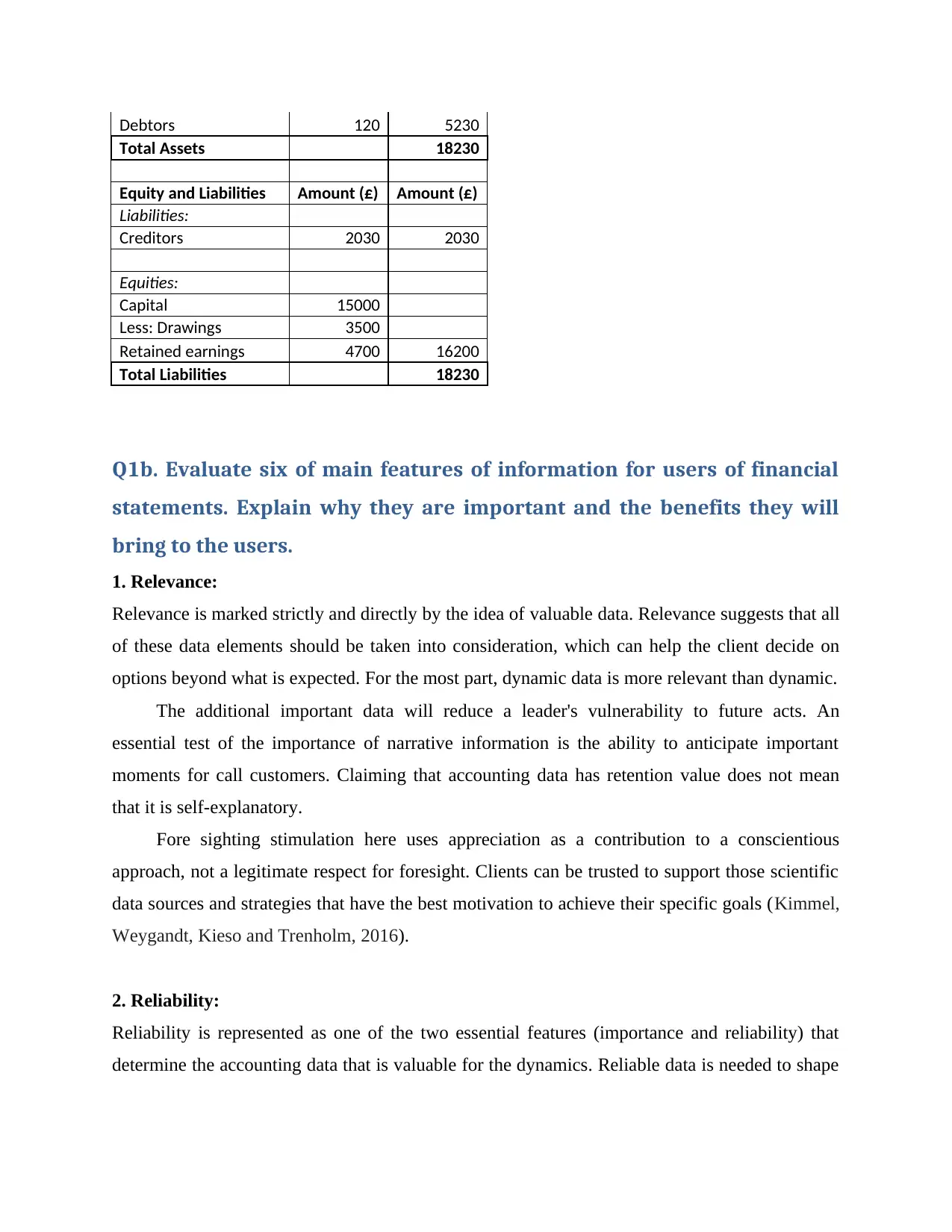
Debtors 120 5230
Total Assets 18230
Equity and Liabilities Amount (£) Amount (£)
Liabilities:
Creditors 2030 2030
Equities:
Capital 15000
Less: Drawings 3500
Retained earnings 4700 16200
Total Liabilities 18230
Q1b. Evaluate six of main features of information for users of financial
statements. Explain why they are important and the benefits they will
bring to the users.
1. Relevance:
Relevance is marked strictly and directly by the idea of valuable data. Relevance suggests that all
of these data elements should be taken into consideration, which can help the client decide on
options beyond what is expected. For the most part, dynamic data is more relevant than dynamic.
The additional important data will reduce a leader's vulnerability to future acts. An
essential test of the importance of narrative information is the ability to anticipate important
moments for call customers. Claiming that accounting data has retention value does not mean
that it is self-explanatory.
Fore sighting stimulation here uses appreciation as a contribution to a conscientious
approach, not a legitimate respect for foresight. Clients can be trusted to support those scientific
data sources and strategies that have the best motivation to achieve their specific goals (Kimmel,
Weygandt, Kieso and Trenholm, 2016).
2. Reliability:
Reliability is represented as one of the two essential features (importance and reliability) that
determine the accounting data that is valuable for the dynamics. Reliable data is needed to shape
Total Assets 18230
Equity and Liabilities Amount (£) Amount (£)
Liabilities:
Creditors 2030 2030
Equities:
Capital 15000
Less: Drawings 3500
Retained earnings 4700 16200
Total Liabilities 18230
Q1b. Evaluate six of main features of information for users of financial
statements. Explain why they are important and the benefits they will
bring to the users.
1. Relevance:
Relevance is marked strictly and directly by the idea of valuable data. Relevance suggests that all
of these data elements should be taken into consideration, which can help the client decide on
options beyond what is expected. For the most part, dynamic data is more relevant than dynamic.
The additional important data will reduce a leader's vulnerability to future acts. An
essential test of the importance of narrative information is the ability to anticipate important
moments for call customers. Claiming that accounting data has retention value does not mean
that it is self-explanatory.
Fore sighting stimulation here uses appreciation as a contribution to a conscientious
approach, not a legitimate respect for foresight. Clients can be trusted to support those scientific
data sources and strategies that have the best motivation to achieve their specific goals (Kimmel,
Weygandt, Kieso and Trenholm, 2016).
2. Reliability:
Reliability is represented as one of the two essential features (importance and reliability) that
determine the accounting data that is valuable for the dynamics. Reliable data is needed to shape
Paraphrase This Document
Need a fresh take? Get an instant paraphrase of this document with our AI Paraphraser
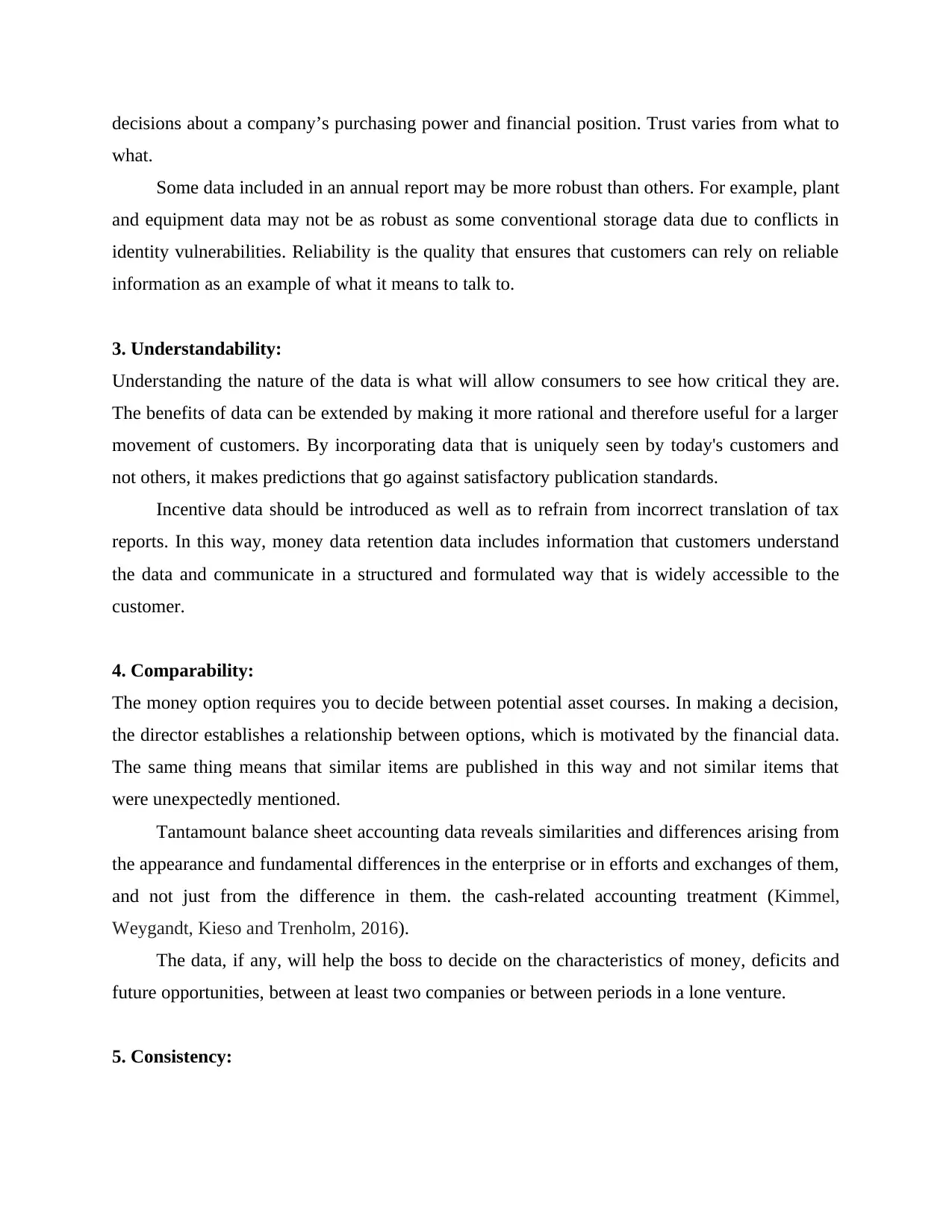
decisions about a company’s purchasing power and financial position. Trust varies from what to
what.
Some data included in an annual report may be more robust than others. For example, plant
and equipment data may not be as robust as some conventional storage data due to conflicts in
identity vulnerabilities. Reliability is the quality that ensures that customers can rely on reliable
information as an example of what it means to talk to.
3. Understandability:
Understanding the nature of the data is what will allow consumers to see how critical they are.
The benefits of data can be extended by making it more rational and therefore useful for a larger
movement of customers. By incorporating data that is uniquely seen by today's customers and
not others, it makes predictions that go against satisfactory publication standards.
Incentive data should be introduced as well as to refrain from incorrect translation of tax
reports. In this way, money data retention data includes information that customers understand
the data and communicate in a structured and formulated way that is widely accessible to the
customer.
4. Comparability:
The money option requires you to decide between potential asset courses. In making a decision,
the director establishes a relationship between options, which is motivated by the financial data.
The same thing means that similar items are published in this way and not similar items that
were unexpectedly mentioned.
Tantamount balance sheet accounting data reveals similarities and differences arising from
the appearance and fundamental differences in the enterprise or in efforts and exchanges of them,
and not just from the difference in them. the cash-related accounting treatment (Kimmel,
Weygandt, Kieso and Trenholm, 2016).
The data, if any, will help the boss to decide on the characteristics of money, deficits and
future opportunities, between at least two companies or between periods in a lone venture.
5. Consistency:
what.
Some data included in an annual report may be more robust than others. For example, plant
and equipment data may not be as robust as some conventional storage data due to conflicts in
identity vulnerabilities. Reliability is the quality that ensures that customers can rely on reliable
information as an example of what it means to talk to.
3. Understandability:
Understanding the nature of the data is what will allow consumers to see how critical they are.
The benefits of data can be extended by making it more rational and therefore useful for a larger
movement of customers. By incorporating data that is uniquely seen by today's customers and
not others, it makes predictions that go against satisfactory publication standards.
Incentive data should be introduced as well as to refrain from incorrect translation of tax
reports. In this way, money data retention data includes information that customers understand
the data and communicate in a structured and formulated way that is widely accessible to the
customer.
4. Comparability:
The money option requires you to decide between potential asset courses. In making a decision,
the director establishes a relationship between options, which is motivated by the financial data.
The same thing means that similar items are published in this way and not similar items that
were unexpectedly mentioned.
Tantamount balance sheet accounting data reveals similarities and differences arising from
the appearance and fundamental differences in the enterprise or in efforts and exchanges of them,
and not just from the difference in them. the cash-related accounting treatment (Kimmel,
Weygandt, Kieso and Trenholm, 2016).
The data, if any, will help the boss to decide on the characteristics of money, deficits and
future opportunities, between at least two companies or between periods in a lone venture.
5. Consistency:
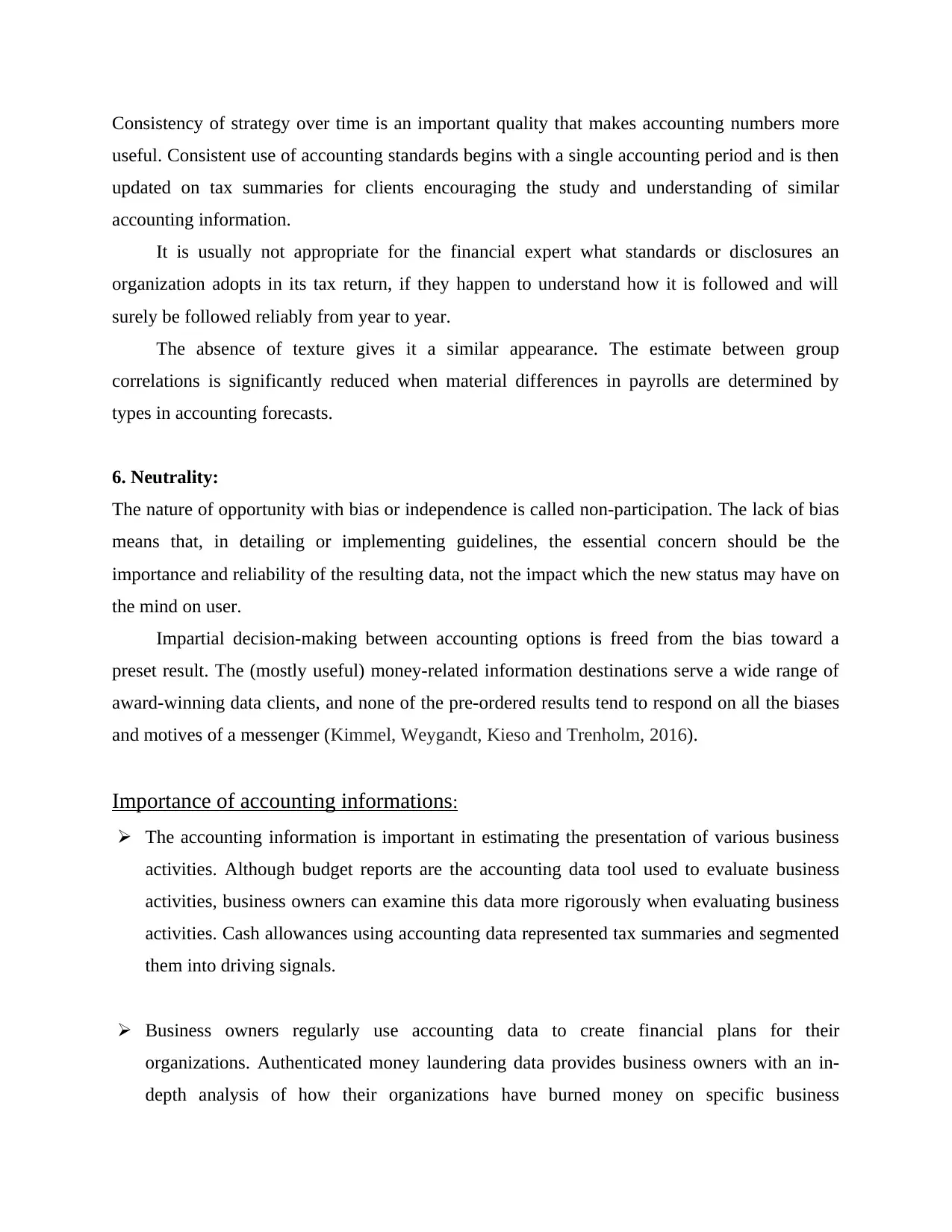
Consistency of strategy over time is an important quality that makes accounting numbers more
useful. Consistent use of accounting standards begins with a single accounting period and is then
updated on tax summaries for clients encouraging the study and understanding of similar
accounting information.
It is usually not appropriate for the financial expert what standards or disclosures an
organization adopts in its tax return, if they happen to understand how it is followed and will
surely be followed reliably from year to year.
The absence of texture gives it a similar appearance. The estimate between group
correlations is significantly reduced when material differences in payrolls are determined by
types in accounting forecasts.
6. Neutrality:
The nature of opportunity with bias or independence is called non-participation. The lack of bias
means that, in detailing or implementing guidelines, the essential concern should be the
importance and reliability of the resulting data, not the impact which the new status may have on
the mind on user.
Impartial decision-making between accounting options is freed from the bias toward a
preset result. The (mostly useful) money-related information destinations serve a wide range of
award-winning data clients, and none of the pre-ordered results tend to respond on all the biases
and motives of a messenger (Kimmel, Weygandt, Kieso and Trenholm, 2016).
Importance of accounting informations:
The accounting information is important in estimating the presentation of various business
activities. Although budget reports are the accounting data tool used to evaluate business
activities, business owners can examine this data more rigorously when evaluating business
activities. Cash allowances using accounting data represented tax summaries and segmented
them into driving signals.
Business owners regularly use accounting data to create financial plans for their
organizations. Authenticated money laundering data provides business owners with an in-
depth analysis of how their organizations have burned money on specific business
useful. Consistent use of accounting standards begins with a single accounting period and is then
updated on tax summaries for clients encouraging the study and understanding of similar
accounting information.
It is usually not appropriate for the financial expert what standards or disclosures an
organization adopts in its tax return, if they happen to understand how it is followed and will
surely be followed reliably from year to year.
The absence of texture gives it a similar appearance. The estimate between group
correlations is significantly reduced when material differences in payrolls are determined by
types in accounting forecasts.
6. Neutrality:
The nature of opportunity with bias or independence is called non-participation. The lack of bias
means that, in detailing or implementing guidelines, the essential concern should be the
importance and reliability of the resulting data, not the impact which the new status may have on
the mind on user.
Impartial decision-making between accounting options is freed from the bias toward a
preset result. The (mostly useful) money-related information destinations serve a wide range of
award-winning data clients, and none of the pre-ordered results tend to respond on all the biases
and motives of a messenger (Kimmel, Weygandt, Kieso and Trenholm, 2016).
Importance of accounting informations:
The accounting information is important in estimating the presentation of various business
activities. Although budget reports are the accounting data tool used to evaluate business
activities, business owners can examine this data more rigorously when evaluating business
activities. Cash allowances using accounting data represented tax summaries and segmented
them into driving signals.
Business owners regularly use accounting data to create financial plans for their
organizations. Authenticated money laundering data provides business owners with an in-
depth analysis of how their organizations have burned money on specific business
⊘ This is a preview!⊘
Do you want full access?
Subscribe today to unlock all pages.

Trusted by 1+ million students worldwide
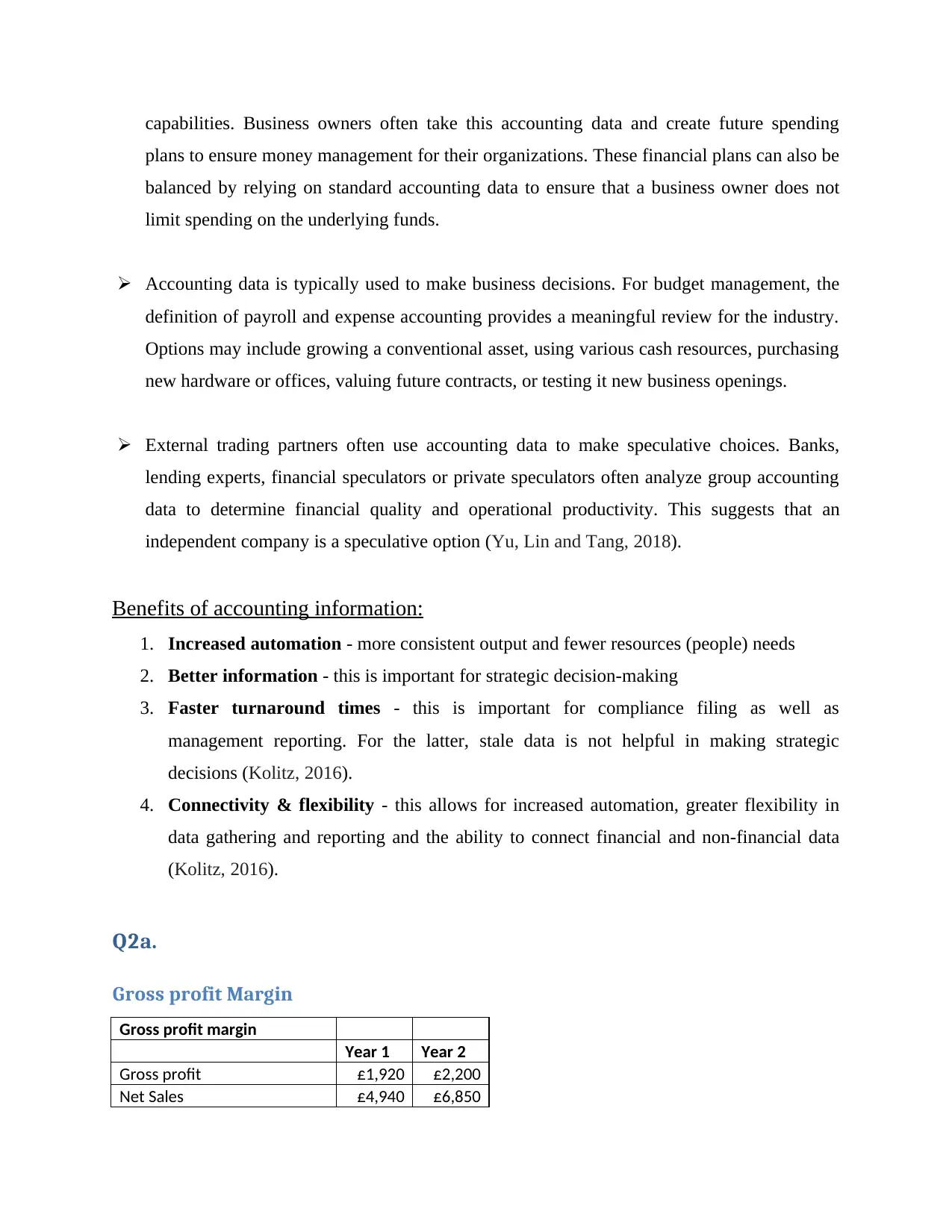
capabilities. Business owners often take this accounting data and create future spending
plans to ensure money management for their organizations. These financial plans can also be
balanced by relying on standard accounting data to ensure that a business owner does not
limit spending on the underlying funds.
Accounting data is typically used to make business decisions. For budget management, the
definition of payroll and expense accounting provides a meaningful review for the industry.
Options may include growing a conventional asset, using various cash resources, purchasing
new hardware or offices, valuing future contracts, or testing it new business openings.
External trading partners often use accounting data to make speculative choices. Banks,
lending experts, financial speculators or private speculators often analyze group accounting
data to determine financial quality and operational productivity. This suggests that an
independent company is a speculative option (Yu, Lin and Tang, 2018).
Benefits of accounting information:
1. Increased automation - more consistent output and fewer resources (people) needs
2. Better information - this is important for strategic decision-making
3. Faster turnaround times - this is important for compliance filing as well as
management reporting. For the latter, stale data is not helpful in making strategic
decisions (Kolitz, 2016).
4. Connectivity & flexibility - this allows for increased automation, greater flexibility in
data gathering and reporting and the ability to connect financial and non-financial data
(Kolitz, 2016).
Q2a.
Gross profit Margin
Gross profit margin
Year 1 Year 2
Gross profit £1,920 £2,200
Net Sales £4,940 £6,850
plans to ensure money management for their organizations. These financial plans can also be
balanced by relying on standard accounting data to ensure that a business owner does not
limit spending on the underlying funds.
Accounting data is typically used to make business decisions. For budget management, the
definition of payroll and expense accounting provides a meaningful review for the industry.
Options may include growing a conventional asset, using various cash resources, purchasing
new hardware or offices, valuing future contracts, or testing it new business openings.
External trading partners often use accounting data to make speculative choices. Banks,
lending experts, financial speculators or private speculators often analyze group accounting
data to determine financial quality and operational productivity. This suggests that an
independent company is a speculative option (Yu, Lin and Tang, 2018).
Benefits of accounting information:
1. Increased automation - more consistent output and fewer resources (people) needs
2. Better information - this is important for strategic decision-making
3. Faster turnaround times - this is important for compliance filing as well as
management reporting. For the latter, stale data is not helpful in making strategic
decisions (Kolitz, 2016).
4. Connectivity & flexibility - this allows for increased automation, greater flexibility in
data gathering and reporting and the ability to connect financial and non-financial data
(Kolitz, 2016).
Q2a.
Gross profit Margin
Gross profit margin
Year 1 Year 2
Gross profit £1,920 £2,200
Net Sales £4,940 £6,850
Paraphrase This Document
Need a fresh take? Get an instant paraphrase of this document with our AI Paraphraser
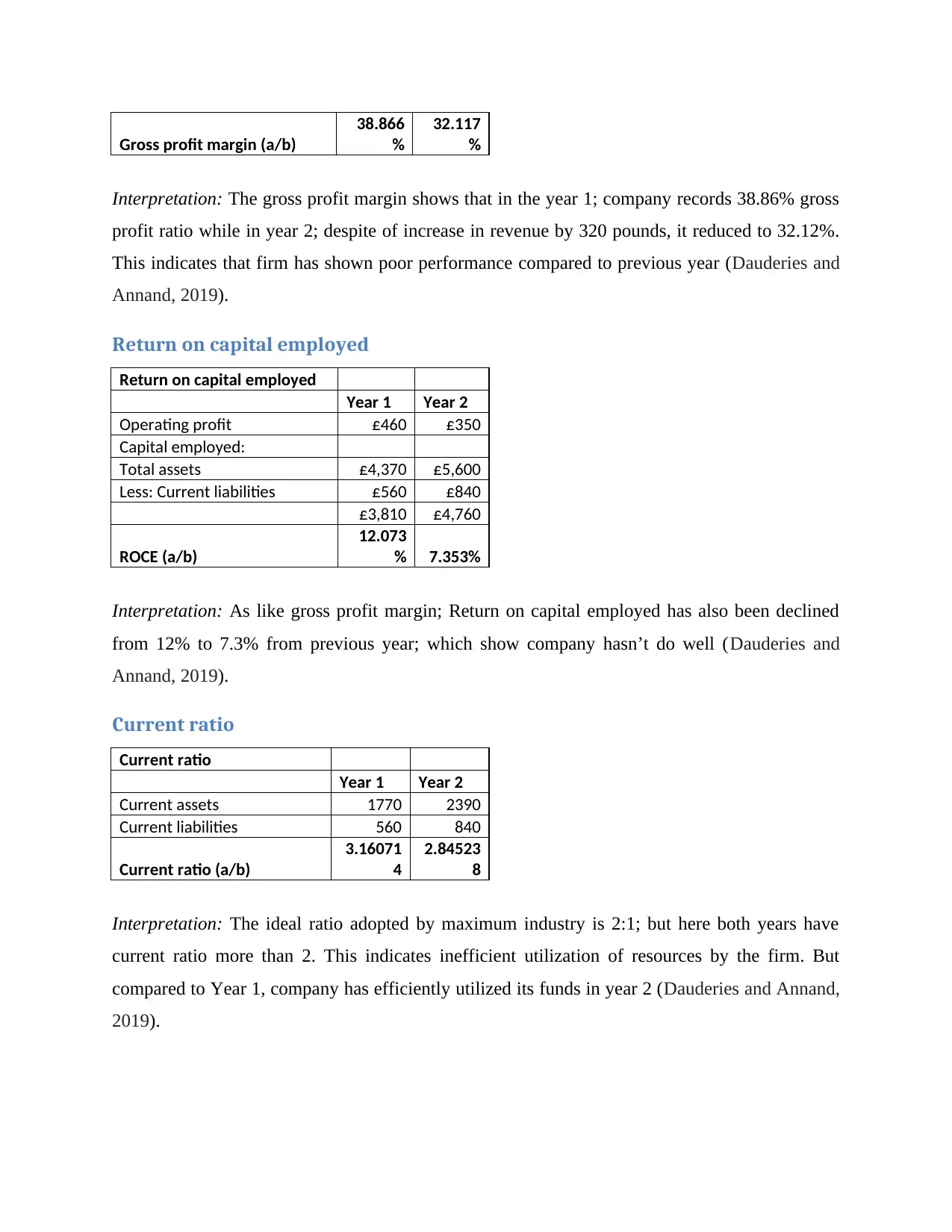
Gross profit margin (a/b)
38.866
%
32.117
%
Interpretation: The gross profit margin shows that in the year 1; company records 38.86% gross
profit ratio while in year 2; despite of increase in revenue by 320 pounds, it reduced to 32.12%.
This indicates that firm has shown poor performance compared to previous year (Dauderies and
Annand, 2019).
Return on capital employed
Return on capital employed
Year 1 Year 2
Operating profit £460 £350
Capital employed:
Total assets £4,370 £5,600
Less: Current liabilities £560 £840
£3,810 £4,760
ROCE (a/b)
12.073
% 7.353%
Interpretation: As like gross profit margin; Return on capital employed has also been declined
from 12% to 7.3% from previous year; which show company hasn’t do well (Dauderies and
Annand, 2019).
Current ratio
Current ratio
Year 1 Year 2
Current assets 1770 2390
Current liabilities 560 840
Current ratio (a/b)
3.16071
4
2.84523
8
Interpretation: The ideal ratio adopted by maximum industry is 2:1; but here both years have
current ratio more than 2. This indicates inefficient utilization of resources by the firm. But
compared to Year 1, company has efficiently utilized its funds in year 2 (Dauderies and Annand,
2019).
38.866
%
32.117
%
Interpretation: The gross profit margin shows that in the year 1; company records 38.86% gross
profit ratio while in year 2; despite of increase in revenue by 320 pounds, it reduced to 32.12%.
This indicates that firm has shown poor performance compared to previous year (Dauderies and
Annand, 2019).
Return on capital employed
Return on capital employed
Year 1 Year 2
Operating profit £460 £350
Capital employed:
Total assets £4,370 £5,600
Less: Current liabilities £560 £840
£3,810 £4,760
ROCE (a/b)
12.073
% 7.353%
Interpretation: As like gross profit margin; Return on capital employed has also been declined
from 12% to 7.3% from previous year; which show company hasn’t do well (Dauderies and
Annand, 2019).
Current ratio
Current ratio
Year 1 Year 2
Current assets 1770 2390
Current liabilities 560 840
Current ratio (a/b)
3.16071
4
2.84523
8
Interpretation: The ideal ratio adopted by maximum industry is 2:1; but here both years have
current ratio more than 2. This indicates inefficient utilization of resources by the firm. But
compared to Year 1, company has efficiently utilized its funds in year 2 (Dauderies and Annand,
2019).
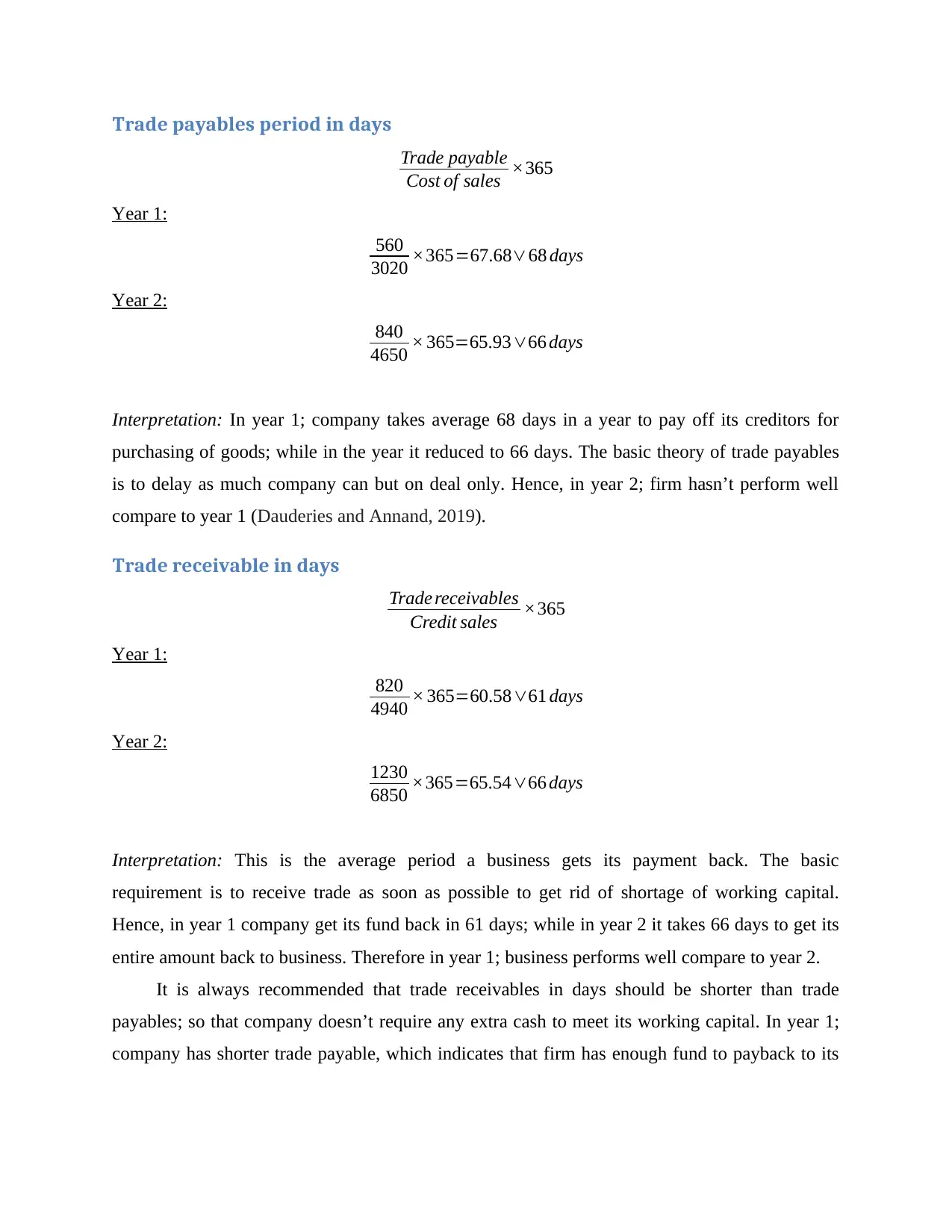
Trade payables period in days
Trade payable
Cost of sales ×365
Year 1:
560
3020 ×365=67.68∨68 days
Year 2:
840
4650 × 365=65.93∨66 days
Interpretation: In year 1; company takes average 68 days in a year to pay off its creditors for
purchasing of goods; while in the year it reduced to 66 days. The basic theory of trade payables
is to delay as much company can but on deal only. Hence, in year 2; firm hasn’t perform well
compare to year 1 (Dauderies and Annand, 2019).
Trade receivable in days
Trade receivables
Credit sales ×365
Year 1:
820
4940 × 365=60.58∨61 days
Year 2:
1230
6850 ×365=65.54∨66 days
Interpretation: This is the average period a business gets its payment back. The basic
requirement is to receive trade as soon as possible to get rid of shortage of working capital.
Hence, in year 1 company get its fund back in 61 days; while in year 2 it takes 66 days to get its
entire amount back to business. Therefore in year 1; business performs well compare to year 2.
It is always recommended that trade receivables in days should be shorter than trade
payables; so that company doesn’t require any extra cash to meet its working capital. In year 1;
company has shorter trade payable, which indicates that firm has enough fund to payback to its
Trade payable
Cost of sales ×365
Year 1:
560
3020 ×365=67.68∨68 days
Year 2:
840
4650 × 365=65.93∨66 days
Interpretation: In year 1; company takes average 68 days in a year to pay off its creditors for
purchasing of goods; while in the year it reduced to 66 days. The basic theory of trade payables
is to delay as much company can but on deal only. Hence, in year 2; firm hasn’t perform well
compare to year 1 (Dauderies and Annand, 2019).
Trade receivable in days
Trade receivables
Credit sales ×365
Year 1:
820
4940 × 365=60.58∨61 days
Year 2:
1230
6850 ×365=65.54∨66 days
Interpretation: This is the average period a business gets its payment back. The basic
requirement is to receive trade as soon as possible to get rid of shortage of working capital.
Hence, in year 1 company get its fund back in 61 days; while in year 2 it takes 66 days to get its
entire amount back to business. Therefore in year 1; business performs well compare to year 2.
It is always recommended that trade receivables in days should be shorter than trade
payables; so that company doesn’t require any extra cash to meet its working capital. In year 1;
company has shorter trade payable, which indicates that firm has enough fund to payback to its
⊘ This is a preview!⊘
Do you want full access?
Subscribe today to unlock all pages.

Trusted by 1+ million students worldwide
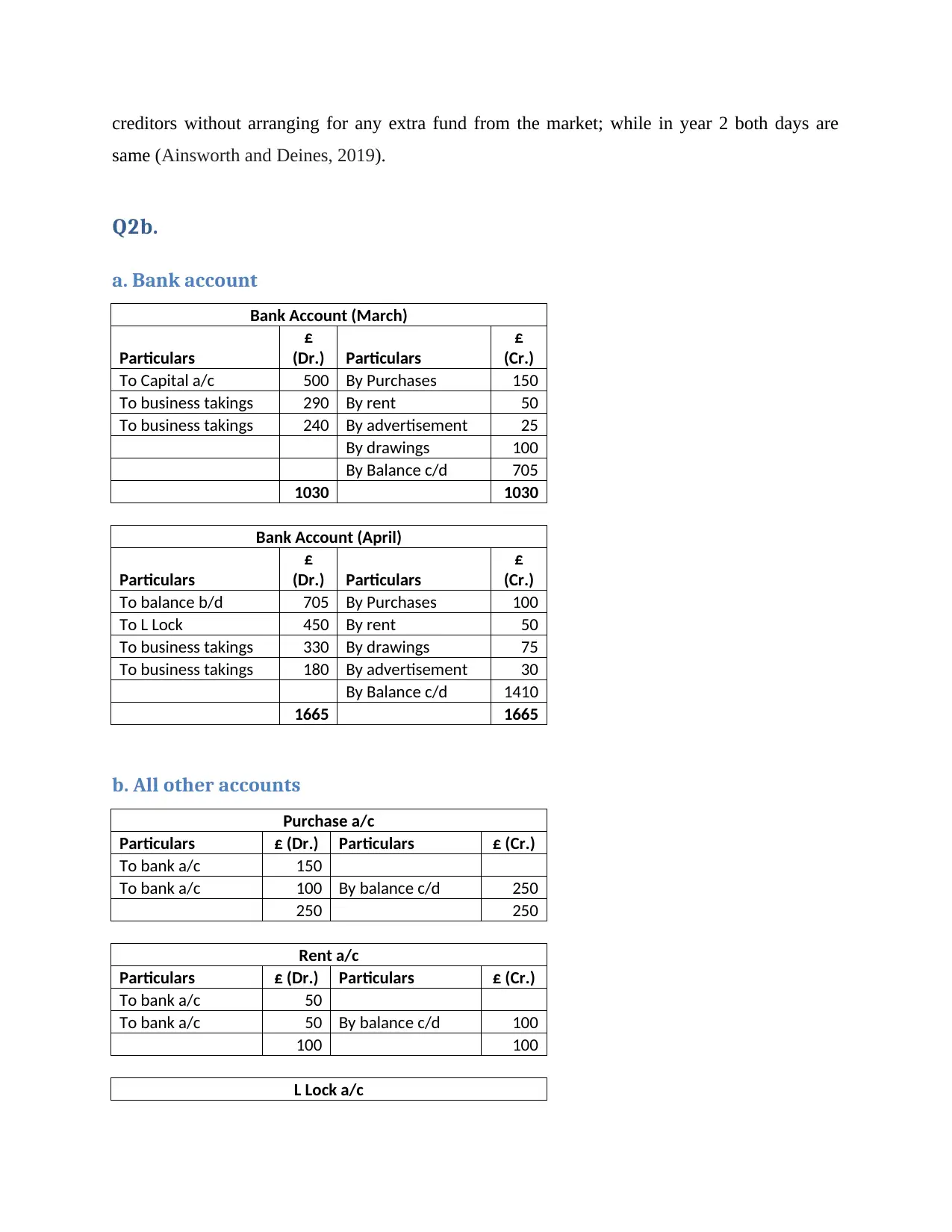
creditors without arranging for any extra fund from the market; while in year 2 both days are
same (Ainsworth and Deines, 2019).
Q2b.
a. Bank account
Bank Account (March)
Particulars
£
(Dr.) Particulars
£
(Cr.)
To Capital a/c 500 By Purchases 150
To business takings 290 By rent 50
To business takings 240 By advertisement 25
By drawings 100
By Balance c/d 705
1030 1030
Bank Account (April)
Particulars
£
(Dr.) Particulars
£
(Cr.)
To balance b/d 705 By Purchases 100
To L Lock 450 By rent 50
To business takings 330 By drawings 75
To business takings 180 By advertisement 30
By Balance c/d 1410
1665 1665
b. All other accounts
Purchase a/c
Particulars £ (Dr.) Particulars £ (Cr.)
To bank a/c 150
To bank a/c 100 By balance c/d 250
250 250
Rent a/c
Particulars £ (Dr.) Particulars £ (Cr.)
To bank a/c 50
To bank a/c 50 By balance c/d 100
100 100
L Lock a/c
same (Ainsworth and Deines, 2019).
Q2b.
a. Bank account
Bank Account (March)
Particulars
£
(Dr.) Particulars
£
(Cr.)
To Capital a/c 500 By Purchases 150
To business takings 290 By rent 50
To business takings 240 By advertisement 25
By drawings 100
By Balance c/d 705
1030 1030
Bank Account (April)
Particulars
£
(Dr.) Particulars
£
(Cr.)
To balance b/d 705 By Purchases 100
To L Lock 450 By rent 50
To business takings 330 By drawings 75
To business takings 180 By advertisement 30
By Balance c/d 1410
1665 1665
b. All other accounts
Purchase a/c
Particulars £ (Dr.) Particulars £ (Cr.)
To bank a/c 150
To bank a/c 100 By balance c/d 250
250 250
Rent a/c
Particulars £ (Dr.) Particulars £ (Cr.)
To bank a/c 50
To bank a/c 50 By balance c/d 100
100 100
L Lock a/c
Paraphrase This Document
Need a fresh take? Get an instant paraphrase of this document with our AI Paraphraser
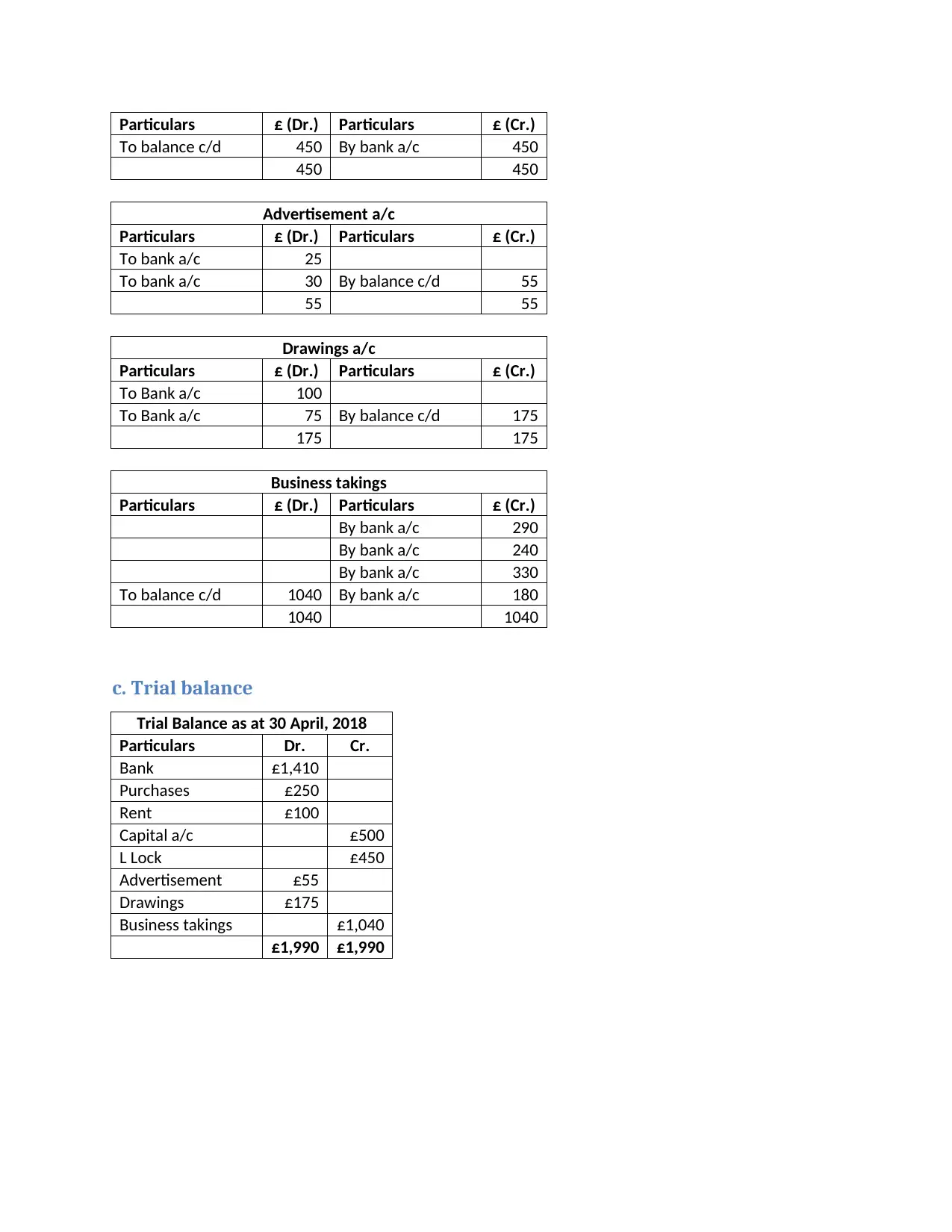
Particulars £ (Dr.) Particulars £ (Cr.)
To balance c/d 450 By bank a/c 450
450 450
Advertisement a/c
Particulars £ (Dr.) Particulars £ (Cr.)
To bank a/c 25
To bank a/c 30 By balance c/d 55
55 55
Drawings a/c
Particulars £ (Dr.) Particulars £ (Cr.)
To Bank a/c 100
To Bank a/c 75 By balance c/d 175
175 175
Business takings
Particulars £ (Dr.) Particulars £ (Cr.)
By bank a/c 290
By bank a/c 240
By bank a/c 330
To balance c/d 1040 By bank a/c 180
1040 1040
c. Trial balance
Trial Balance as at 30 April, 2018
Particulars Dr. Cr.
Bank £1,410
Purchases £250
Rent £100
Capital a/c £500
L Lock £450
Advertisement £55
Drawings £175
Business takings £1,040
£1,990 £1,990
To balance c/d 450 By bank a/c 450
450 450
Advertisement a/c
Particulars £ (Dr.) Particulars £ (Cr.)
To bank a/c 25
To bank a/c 30 By balance c/d 55
55 55
Drawings a/c
Particulars £ (Dr.) Particulars £ (Cr.)
To Bank a/c 100
To Bank a/c 75 By balance c/d 175
175 175
Business takings
Particulars £ (Dr.) Particulars £ (Cr.)
By bank a/c 290
By bank a/c 240
By bank a/c 330
To balance c/d 1040 By bank a/c 180
1040 1040
c. Trial balance
Trial Balance as at 30 April, 2018
Particulars Dr. Cr.
Bank £1,410
Purchases £250
Rent £100
Capital a/c £500
L Lock £450
Advertisement £55
Drawings £175
Business takings £1,040
£1,990 £1,990
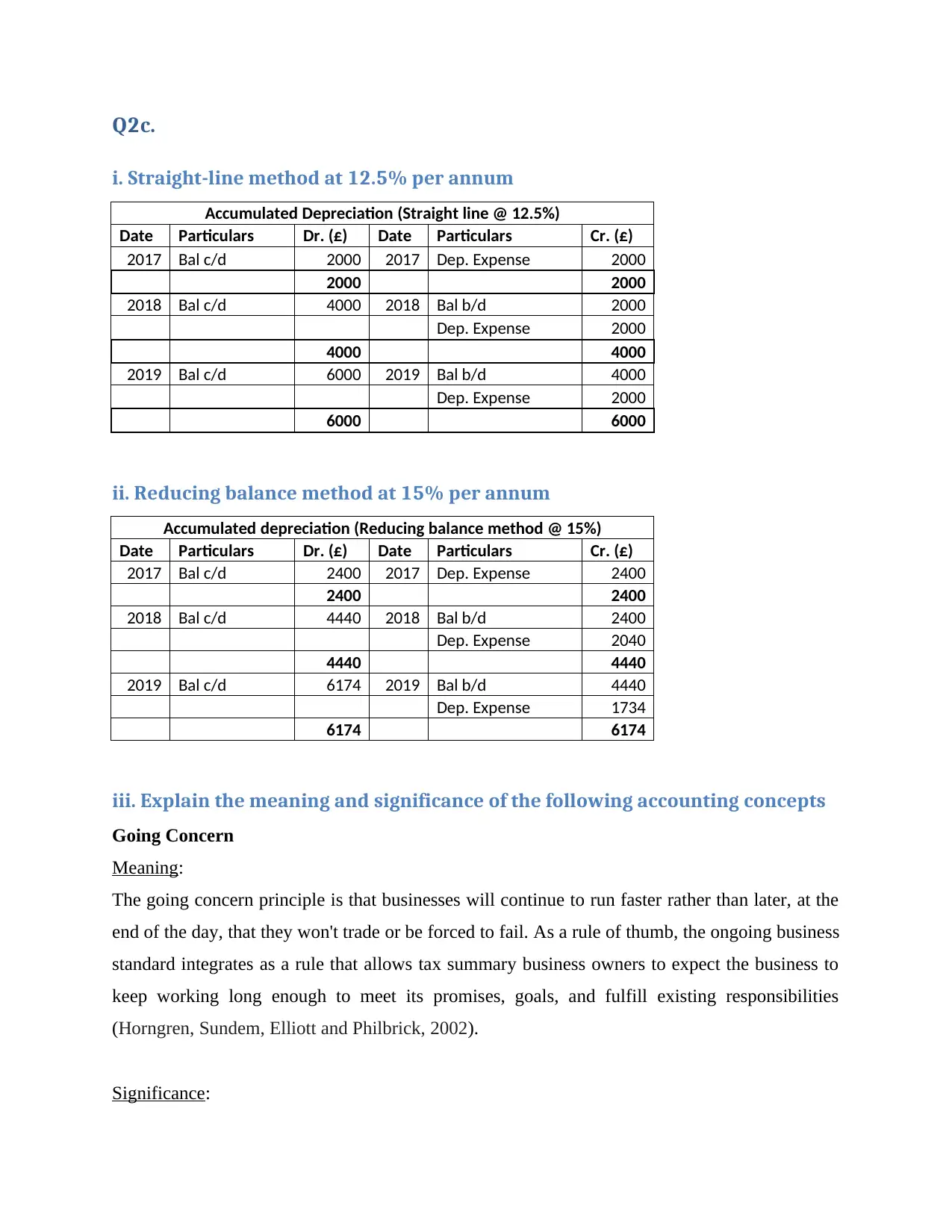
Q2c.
i. Straight-line method at 12.5% per annum
Accumulated Depreciation (Straight line @ 12.5%)
Date Particulars Dr. (£) Date Particulars Cr. (£)
2017 Bal c/d 2000 2017 Dep. Expense 2000
2000 2000
2018 Bal c/d 4000 2018 Bal b/d 2000
Dep. Expense 2000
4000 4000
2019 Bal c/d 6000 2019 Bal b/d 4000
Dep. Expense 2000
6000 6000
ii. Reducing balance method at 15% per annum
Accumulated depreciation (Reducing balance method @ 15%)
Date Particulars Dr. (£) Date Particulars Cr. (£)
2017 Bal c/d 2400 2017 Dep. Expense 2400
2400 2400
2018 Bal c/d 4440 2018 Bal b/d 2400
Dep. Expense 2040
4440 4440
2019 Bal c/d 6174 2019 Bal b/d 4440
Dep. Expense 1734
6174 6174
iii. Explain the meaning and significance of the following accounting concepts
Going Concern
Meaning:
The going concern principle is that businesses will continue to run faster rather than later, at the
end of the day, that they won't trade or be forced to fail. As a rule of thumb, the ongoing business
standard integrates as a rule that allows tax summary business owners to expect the business to
keep working long enough to meet its promises, goals, and fulfill existing responsibilities
(Horngren, Sundem, Elliott and Philbrick, 2002).
Significance:
i. Straight-line method at 12.5% per annum
Accumulated Depreciation (Straight line @ 12.5%)
Date Particulars Dr. (£) Date Particulars Cr. (£)
2017 Bal c/d 2000 2017 Dep. Expense 2000
2000 2000
2018 Bal c/d 4000 2018 Bal b/d 2000
Dep. Expense 2000
4000 4000
2019 Bal c/d 6000 2019 Bal b/d 4000
Dep. Expense 2000
6000 6000
ii. Reducing balance method at 15% per annum
Accumulated depreciation (Reducing balance method @ 15%)
Date Particulars Dr. (£) Date Particulars Cr. (£)
2017 Bal c/d 2400 2017 Dep. Expense 2400
2400 2400
2018 Bal c/d 4440 2018 Bal b/d 2400
Dep. Expense 2040
4440 4440
2019 Bal c/d 6174 2019 Bal b/d 4440
Dep. Expense 1734
6174 6174
iii. Explain the meaning and significance of the following accounting concepts
Going Concern
Meaning:
The going concern principle is that businesses will continue to run faster rather than later, at the
end of the day, that they won't trade or be forced to fail. As a rule of thumb, the ongoing business
standard integrates as a rule that allows tax summary business owners to expect the business to
keep working long enough to meet its promises, goals, and fulfill existing responsibilities
(Horngren, Sundem, Elliott and Philbrick, 2002).
Significance:
⊘ This is a preview!⊘
Do you want full access?
Subscribe today to unlock all pages.

Trusted by 1+ million students worldwide
1 out of 15
Related Documents
Your All-in-One AI-Powered Toolkit for Academic Success.
+13062052269
info@desklib.com
Available 24*7 on WhatsApp / Email
![[object Object]](/_next/static/media/star-bottom.7253800d.svg)
Unlock your academic potential
Copyright © 2020–2025 A2Z Services. All Rights Reserved. Developed and managed by ZUCOL.




